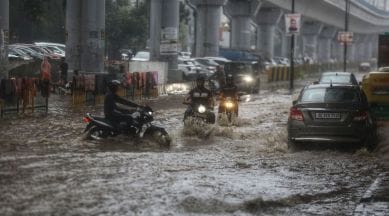Stay updated with the latest - Click here to follow us on Instagram
G-20 days away, Delhi puts final touches to its waterlogging plan
At the main Summit site at Pragati Maidan and nearby Bhairon Marg, which is prone to waterlogging that often results in the inundation of the tunnel leading up to Ring Road, the L-G instructed officials to set up a graded water evacuation plan.

An elaborate contingency plan will be implemented to deal with waterlogging triggered by possible heavy rainfall in the run-up to, and during, next month’s G-20 Summit in the national capital.
According to L-G House officials, the plan involves specific arrangements at locations that saw waterlogging last month. Several arterial routes in the city, including those in the heart of Delhi, had been inundated in July by continuous spells of rain on the one hand and the Yamuna in spate on the other.
monthly limit of free stories.
with an Express account.
On Wednesday, Lieutenant Governor VK Saxena walked from Pragati Maidan Gate No 5 on Bhairon Marg to Rajghat and reviewed the functioning of arrangements to prevent flooding; the area was among the most prominent ones to witness waterlogging last month.
He also reviewed arrangements at Rajghat to address any eventuality of flooding at the memorial. He then issued directions to ensure a plan was in place to deal with waterlogging around ITPO, Rajghat, hotels designated for delegates, and other strategic locations in case it rained heavily.
“The L-G has issued directions to ensure there is no waterlogging along routes taken by the dignitaries and delegates during the event. The plan involves placement of tractor-mounted, heavy-duty 50 HP pumps for clearing excess water as and when required,” an official said.
This, according to the official, is in addition to the mechanical road sweeping (MRS) vehicles, which are also mounted with heavy water jetting machines to clear mud and silt accumulated on the roadsides and a super sucker to clear clogged drains and sewer lines.
“These vehicles, on duty 24×7 in 12-hour shifts, are manned by an MRS operator, a sanitary inspector, a helper and a probationer IAS or DANICS officer. They are also accompanied by a vehicle with workmen and equipment to address and resolve any civil work on the roads,” the official added.
At the main Summit site at Pragati Maidan and nearby Bhairon Marg, which is prone to waterlogging that often results in the inundation of the tunnel leading up to Ring Road, the L-G instructed officials to set up a graded water evacuation plan.
This involves water first getting collected in small reservoirs of 1,000-litre capacity, from where they are pumped into reservoirs of 2,000-litre capacity and thereafter to a large reservoir of 50,000-litre capacity.
“Finally, the collected water is pumped into the neighbouring drain No. 12 for discharge into the Yamuna,” the official added.